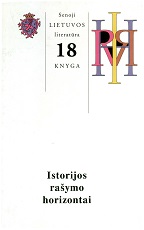Baroko žmogaus paveikslas laidotuvių pamoksluose: tarp tikrovės ir idealybės
The image of the baroque main in the funeral sermons: between the real and the ideal
Author(s): Viktorija VaitkevičiūtėSubject(s): Literary Texts
Published by: Lietuvių literatūros ir tautosakos institutas
Keywords: sermons by famous preachers of the 17th century Grand Duchy of Lithuania; like Jokūbas Olševskis; Bonaventūra Čarlinskis; Augustinas Vitunskis; Albertas Ceciševskis; Aleksas Dubrovičius; Motiejus Kazimieras Sarbievijus; Fabijonas Birkovskis and Žygimantas
Summary/Abstract: The author of the article analyses sermons by famous preachers of the 17th century Grand Duchy of Lithuania, like Jokūbas Olševskis, Bonaventūra Čarlinskis, Augustinas Vitunskis, Albertas Ceciševskis, Aleksas Dubrovičius, Motiejus Kazimieras Sarbievijus, Fabijonas Birkovskis and Žygimantas Liauksminas, as well as Petras Skarga and Kazimieras Jonas Vaišnoravičius, searching for an answer, as to what extent the generalized model of the Christian, the believer exists in them, and how many biographical details these creators really use. Both female and male models get discussed in the article: those of nobles, generals, priests and scribes, including their origins, virtues, life achievements and the worthy Christian death. Religious devotion is named as the main one among their distinguishing features and virtues (including generous giving of alms, patronizing a church institution, attending the religious practices, or displaying readiness to fight defending one’s faith and Church). Images of royals, hetmans, voivodes, knights and matrons, etc., created in the funeral sermons, get individualized only considering the limitations imposed by their social status. A person gets described according to the requirements of rhetoric, while moments from his/her life history only serve to persuade the public of him/her having really existed. To the contemporary reader, restricted by precise religious and moral doctrine, and looking in literature for the individual relationship to the world, for verification of one’s own attitude, the funeral sermons presented not only the glorious document of the whole family, but also a pious reading.
Journal: Senoji Lietuvos literatūra
- Issue Year: 2004
- Issue No: XVIII
- Page Range: 188-212
- Page Count: 23
- Language: Lithuanian

